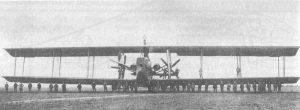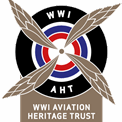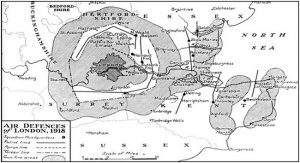Eventually, the British defences prevailed. The London Air Defence Area was created once the Barrage Defence concept proved outdated as aircraft grew more capable and it was necessary to be able to concentrate force to defeat the enemy. The shaded areas represent the areas marked for anti-aircraft artillery with the patrol lines in between. These command and control arrangements were in place for the Battle of Britain 22 years later except for radar which Dowding brilliantly integrated into the Air Defence system between the Wars. Advanced types such as the SE5a and Sopwith Camel were easily adapted for night-fighting as the Gothas, under increasing pressure, switched from daylight to nocturnal operations. They were later joined by the enormous Riesenflugzeuge (Giant Aircraft): immense multi-engined biplane bombers with wingspans exceeding even the WWII B.17 and Lancaster. These behemoths could carry a far heavier bomb-load than the Gothas and were armed with up to seven defensive machine guns. Not one of them was ever shot down over British soil.


